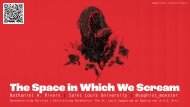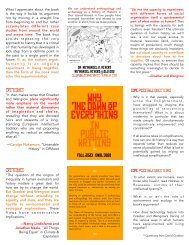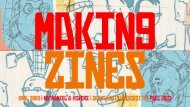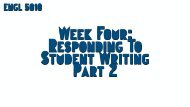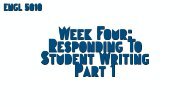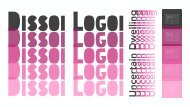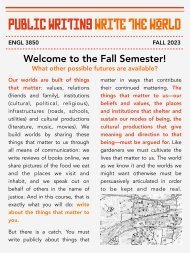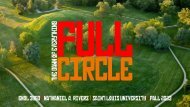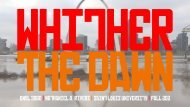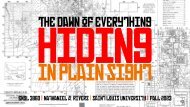ENGL 4010: Aesthetics Slide Deck (SP23)
Create successful ePaper yourself
Turn your PDF publications into a flip-book with our unique Google optimized e-Paper software.
<strong>Aesthetics</strong><br />
New Media Writing
anaesthesia, n.<br />
Modern Latin, < Greek ἀναισθησία want of feeling, < ἀν priv.<br />
+ αἴσθησι-ς sensation, < stem αἰσθε-, to feel, perceive.
aesthetic, n. and adj.<br />
Ultimately < ancient Greek αἰσθητικός of or relating to sense<br />
perception, sensitive, perceptive < αἰσθητός sensible, perceptible<br />
( < the stem of αἰσθάνεσθαι to perceive (see aesthesis n.) + -τός ,<br />
suffix forming verbal adjectives) + -ικός -ic suffix.
• languages are aesthetics<br />
• metaphors are aesthetics<br />
• senses are aesthetics<br />
• media are aesthetics<br />
• sensors are aesthetics
there’s no such thing<br />
as a synonym
earth<br />
globe<br />
Sol 3<br />
planet<br />
spaceship earth<br />
Gaia<br />
world<br />
blue marble
The swimming sea cucumber,<br />
Enypniastes eximia,<br />
sometimes referred to as<br />
the headless chicken<br />
monster. NOAA Office of<br />
Ocean Exploration and<br />
Research.
When humans encounter life-forms that are unfamiliar or strange<br />
Imbler<br />
to us, our instinct is often to distance ourselves from them. We<br />
gawk at how the blueprint of their body veers from our own.<br />
Sometimes they confuse or repulse us. Reports about the blue goo<br />
described it as “formless, faceless and limbless,” descriptors defined<br />
in opposition to ourselves, our faces and our limbs. Before we have a<br />
chance to know what the blue goo might be, we are told that<br />
whatever it is, it is not like us.
Imbler<br />
Sometimes this comparison with an alien world becomes more<br />
literal. One popular trope in discussing the deep sea is that humans<br />
know more about the surface of Mars than the ocean floor. But this<br />
comparison assumes mapping a place is all that constitutes<br />
exploration, and it minimizes the knowledge we do have of what<br />
lives on that surface.
One of the easiest ways to connect with creatures is through<br />
Imbler<br />
anthropomorphism—looking to organisms for reflections of<br />
ourselves. Anthropomorphism has had a bad rap as unscientific, but<br />
it’s a natural inclination, and, in my view, it can be protective. It<br />
prompts us to care about the killer whale mourning her calf, the<br />
elephants burying their family members with leaves and dirt, even the<br />
octopus fleeing an aquarium for the freedom of the ocean. To ignore<br />
or deny the ways we see ourselves in animals might enable our<br />
exploitation of them, such as through factory farms.
The painting appeals to us<br />
precisely because it both<br />
Ingold<br />
chimes with our experience<br />
of what it feels like to be<br />
under the stars and affords<br />
us the means to dwell upon<br />
it—perhaps to discover<br />
depths in this experience of<br />
which we would otherwise<br />
remain unaware.<br />
The Starry Night, Vincent van Gogh (1889)
Dad Out At Night, Scarlett<br />
“Scootch” Rivers (2023)
Dad Out At Night, Scarlett<br />
“Scootch” Rivers (2023)
Ingold<br />
Of course there could be no experience of light without the<br />
incidence of radiant energy, or without the excitation of<br />
photoreceptors in the retina, but as an affectation of being<br />
—as the experience of inhabiting an illuminated world<br />
—light is reducible to neither. Nevertheless this<br />
experience is entirely real.
To witness the sun is to see by its own light, or, in the<br />
Ingold<br />
poetic language of Johann Wolfgang von Goethe, ‘if the<br />
eye were not sun-like, it could not see the sun.’ By<br />
‘sun-like,’ Goethe did not mean to imply a relation of formal<br />
eyeballs. His point was rather that the same sun that<br />
shines in the sky (the beacon) also shines from our eyes<br />
(the beam). It is what we see with.
For von Uexküll, however, the sun in its shining was to be<br />
Ingold<br />
understood not as a physical entity but as a manifest<br />
presence in the world of phenomena. And in this sense, just<br />
as the eye, as Goethe had observed, can see only by virtue of<br />
its correspondence with the sun, so the sun we perceive in the<br />
sky, and that lights the world of our experience, can exist only<br />
through its essential correspondence with the eye.
Ingold<br />
Van Gogh, then, is not just painting stars. He is a star-struck<br />
painter: he sees, and paints, with their light. This is why the<br />
stars can be at once infinitely distant and yet touch the soul.
Laudato Si’<br />
The bishops of Japan, for their part, made a thought-provoking observation:<br />
“To sense each creature singing the hymn of its existence is to live<br />
joyfully in God’s love and hope.” This contemplation of creation allows us to<br />
discover in each thing a teaching which God wishes to hand on to us, since<br />
“for the believer, to contemplate creation is to hear a message, to listen to a<br />
paradoxical and silent voice”. We can say that “alongside revelation properly<br />
so-called, contained in sacred Scripture, there is a divine manifestation in<br />
the blaze of the sun and the fall of night”. Paying attention to this<br />
manifestation, we learn to see ourselves in relation to all other creatures: “I<br />
express myself in expressing the world; in my effort to decipher the<br />
sacredness of the world, I explore my own”.
Sensors observe, assess, synthesize, and manage<br />
Gabrys<br />
measurements of Earth processes. They typically operate<br />
as networks to detect, analyze, and actuate responses<br />
to environmental events.
Gabrys<br />
Yet, these sensor installations are not just ways of<br />
describing environments, they are also ways of bringing<br />
them into being as sociopolitical worlds, with often<br />
disparate power relations.
Gabrys<br />
These planetaries signal how practices of observation<br />
involve ways of experiencing that are also<br />
propositions for how to collectively inhabit a moving<br />
Earth.
earth<br />
globe<br />
sol 3<br />
planet<br />
spaceship earth<br />
gaia<br />
world<br />
blue marble
[T]he Coronavirus outbreak is forcing us<br />
Maiello<br />
to collectively and seriously ask<br />
ourselves: what is a medium? The<br />
emergency, of course, cannot be<br />
reduced to this question, but doctors and<br />
scientists are telling us they cannot do it<br />
by themselves, that each of us needs to<br />
play our part. Playing our part today<br />
means that we also collectively<br />
process our being media.
Casey Boyle, March 2020.
Maiello<br />
It is necessary to underline that this pervasive capacity of media<br />
and media practices, which directly affect us, is not the result of the<br />
evil of technics or media (another pivotal issue which often becomes<br />
a source of general misunderstandings). The power of technics has to<br />
be ascribed, first of all, to the fact that media answer to a natural<br />
disposition of human beings, that is adapting ourselves to our own<br />
environment through technical artifacts, devices which are nothing<br />
more than bodily and mental extensions.
Maiello<br />
We will physically go back to the squares, the classrooms, the bars<br />
and cafes, with the awareness that living up to being radical<br />
mediators means opening up a new experimental stage in order<br />
to create an increasingly integrative mediality, which can never be<br />
completely substituted by technics. In the aftermath of this crisis we<br />
will be challenged to reintegrate our own mediality with the<br />
sociotechnical networks that are for the time being substituting<br />
for our embodied relationality.
<strong>Aesthetics</strong><br />
New Media Writing




